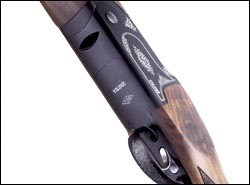Yildiz over-and-under shotgun review
There is no shortage of good value over-unders - so what, if anything, sets the Yildiz apart?

Yildiz over-and-under shotgun review
Manufacturer: Yildiz
Pros: Lightweight, price
Price as reviewed: £480
Cons: Stock dimensions, coarse and heavy trigger
It is certainly priced competitively, in basic grade at least. The black action SPZME on test comes in a choice of 12 or 20-bore and retails at £480 with fixed choke barrels, or at £499 with multi-chokes. This is a very keen price point. There is also a heavily engraved version for £755.
Perhaps what really makes the Yildiz stand out is that it’s built on a lightweight alloy action and is certainly the cheapest gun of its type currently available. The use of alloy brings the weight down considerably – to 2.7kg (6lb) or so for the 20-bore, and 3kg (6.3/4lb) for the 12-bore.
As a handy roughshooting gun, this makes it an attractive proposition. Only the action frame is completely alloy; the lock and ejector work is steel, while a titanium insert in the breech face protects against wear around the striker holes.
The insert is held in place by an exposed screw head, so I presume it is easily replaced. The action itself is similar to many of the cheaper Italian guns we see over here: the barrels hinge on stub pins in the action walls; there is a full-width locking bolt engaging a bite below the bottom barrel, and a substantial cocking rod runs along the floor of the action. Given this tried and tested layout, there should be few worries about the gun’s basic construction. The boxlock lock work is similarly simple and robust.
Barrels
Only 28in barrels are offered, as much for balance as anything, I suspect. Lightweight actions have most weight removed from between the hands, but the barrels are the same as on a normal gun. Weight distribution tends towards nose-heaviness as a result and would only be accentuated with longer barrels. Both 12 and 20-bore barrels come with 3in (76mm) chambers as standard, giving the owner a wide choice of ammunition – whether you would actually want to fire 3in magnum cartridges in a 6lb 20-bore is another matter. Incidentally, all the guns are submitted for proof in this country.
Top and mid-ribs are ventilated, the 8mm parallel top-rib having a plain cross-cut finish. A simple brass bead is fitted. The test gun came with multi-chokes and a full set of five chokes is supplied, of reasonable quality; I suspect most will consider them worth the small extra cost.
Finish
The machining is of acceptable quality, given the price, though the action is kept plain, with no attempt to relieve or disguise the rather slab-sided look. Instead, the plain black action is given some scroll decoration, filled in white. The white does rather leap out at you; on what is essentially a workhorse gun I would be much happier with solid black.
The woodwork is stained dark and finished with what looks to be synthetic semi-gloss oil. It is let down a little by the coarse chequering (about 18 lines per inch), which has noticeable overruns in several places. A solid and very firm rubber pad completes the stock.
On test
Beginning with stock dimensions, the length is average at 370mm (14.1/2in), but I felt immediately that the comb had been set rather low. A quick check with the ruler revealed 40mm drop at the nose, 60mm at the heel. Most off-the-peg guns now are set with a drop of 35/55mm, which might be a more suitable specification for the Yildiz.
The trigger – a manual design, not the more common inertia block system – will win few prizes. My gauge recorded pulls of 6.1/2lb for the first barrel and about half a pound more for the second. Moreover, they have a lot of drag, which might put off some. The same applies to the other ‘controls’, notably the top-lever and the manual safety. The ejectors work powerfully and are well timed.
As expected, the balance is slightly nose heavy, but not excessively so. I like the steadiness a weight-forward bias gives, so found the handling to my taste.
The semi-beavertail fore-end sits nicely in the hand, but I found it harder to get a comfortable position for my right hand. The measurement from the centre of the trigger blade to the nose of the comb is quite short, leaving the fleshy pad at the base of the thumb cramped for room. This will be even more of an issue for those with larger hands than mine.
The main selling point of the Yildiz is its weight, or lack of it. You will need to spend circa £800 for a similarly specified gun from one of the Italian manufacturers, but there is a tangible quality difference. My computer terms my mouse a ‘human interface device’, and it is precisely in this area of human interface, lacking the charm of its .410 sibling, that the Yildiz over-under falls short.








